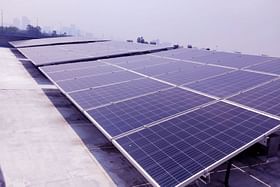It is estimated that about 10 million units of solar energy will be generated from the planned solar plants, which will be used by NCRTC mostly for meeting its auxiliary consumption of stations/buildings etc.
Moving towards its target of meeting 70 per cent of the total power requirement of Delhi-Ghaziabad-Meerut RRTS corridor from in-house solar plants and external renewable energy sources, NCRTC has achieved its first milestone in this direction.
National Capital Region Transport Corporation (NCRTC)’s first solar power plant has started generating power.
The solar power plant has been installed at the rooftop of Ghaziabad Receiving Substation (RSS) and a total of 54 solar panels have been installed on its roof.
The size of these panels is approximately 1 m x 2 m. About 25,000 units of electricity can be generated every year by these solar panels.
Energy generated from solar power plants is being used by NCRTC under the Renewable energy service company (RESCO) model. Under this model, the service provider company produces energy by installing solar power plants at the locations provided.
NCRTC has not invested anything but has to pay for the energy charges supplied by the developer, at the rate decided through competitive bidding.
The generated power is to be used for meeting auxiliary consumption of stations/buildings etc. The power supply from Ghaziabad RSS has started and is being used to meet local requirements.
NCRTC has identified about 11 Megawatt Peak (MWp) solar power potential on the rooftop of stations and buildings of Delhi-Ghaziabad-Meerut RRTS corridor.
It is estimated that about 10 million units of solar energy will be generated from these plants, which will be used by NCRTC mostly for meeting its auxiliary consumption of stations/buildings etc.
NCRTC has planned a target of meeting about 70 per cent of the total energy requirement from renewable energy sources. The work of installation of solar panels at stations, depots and other places of the RRTS corridor is going on at present.
NCRTC is also committed to efficient energy consumption. RRTS trains are equipped with a state-of-the-art regenerative braking system, which converts the kinetic energy of the train into electrical energy.
Regenerative braking will result in reduced wear and tear of wheels, brake pads and other associated moving brake-gear parts of rolling stock, resulting in significantly reduced consumption of these spare parts/items during the maintenance life cycle of the train.
This helps in substantial reduction in carbon-di-oxide (CO2) emissions that would have been generated in the manufacturing and supply chain process of these spare parts.
In addition, all RRTS stations and their premises, depots, offices and trains will be equipped with energy-saving LED lights. Platform screen doors will be installed at each RRTS station, which will help in saving significant energy consumption in underground stations as well.
Through the use of clean energy, these efforts of NCRTC will ensure reduction in cost of electricity and substantial reduction in CO2 emissions, which is essential for sustainable development.
NCRTC is looking forward to completing the priority section with all passenger amenities in the month of March, say its officials.


